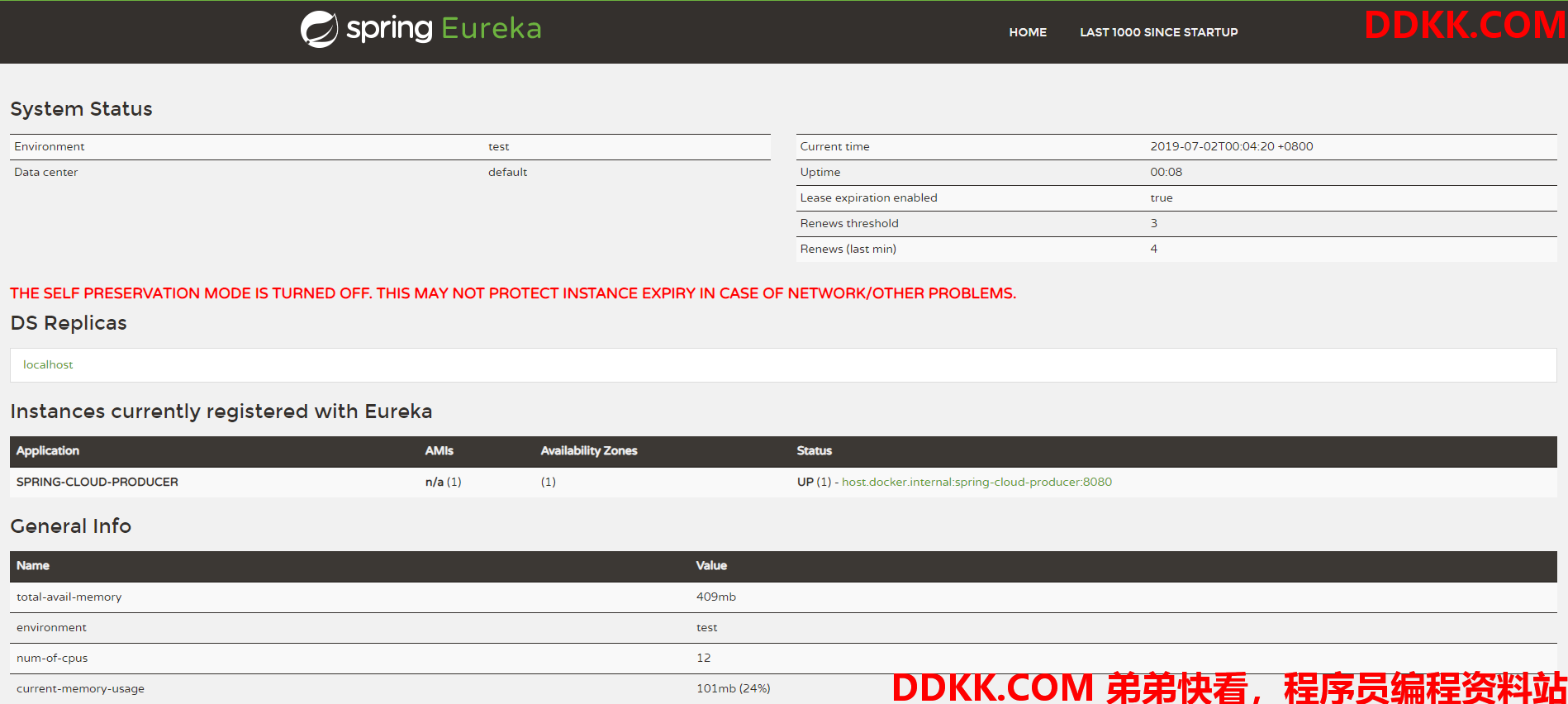Springboot: 2.1.6.RELEASE
SpringCloud: Greenwich.SR1
如无特殊说明,本系列教程全采用以上版本
上一篇,我们介绍了注册中心的搭建,包括集群环境吓注册中心的搭建,这篇文章介绍一下如何使用注册中心,创建一个服务的提供者,使用一个简单的客户端去调用服务端提供的服务。
本篇文章中需要三个角色,分别是服务的提供者,服务的消费者,还有一个是上一篇文章的主角——注册中心Eureka(使用单机版本即可,本篇的示例也会使用单机版本的Eureka)。
整体流程为:
1、 先启动注册中心Eureka;
2、 启动服务的提供者将提供服务,并将服务注册到注册中心Eureka上;
3、 启动服务的消费者,在注册中心中找到服务并完成消费;
1. 服务提供者
1. pom.xml
<?xml version="1.0" encoding="UTF-8"?>
<project xmlns="http://maven.apache.org/POM/4.0.0" xmlns:xsi="http://www.w3.org/2001/XMLSchema-instance"
xsi:schemaLocation="http://maven.apache.org/POM/4.0.0 http://maven.apache.org/xsd/maven-4.0.0.xsd">
<modelVersion>4.0.0</modelVersion>
<parent>
<groupId>org.springframework.boot</groupId>
<artifactId>spring-boot-starter-parent</artifactId>
<version>2.1.6.RELEASE</version>
<relativePath/> <!-- lookup parent from repository -->
</parent>
<groupId>com.springcloud</groupId>
<artifactId>producer</artifactId>
<version>0.0.1-SNAPSHOT</version>
<name>producer</name>
<description>Demo project for Spring Boot</description>
<properties>
<java.version>1.8</java.version>
<spring-cloud.version>Greenwich.SR1</spring-cloud.version>
</properties>
<dependencies>
<dependency>
<groupId>org.springframework.boot</groupId>
<artifactId>spring-boot-starter-web</artifactId>
</dependency>
<dependency>
<groupId>org.springframework.cloud</groupId>
<artifactId>spring-cloud-starter-netflix-eureka-client</artifactId>
</dependency>
<dependency>
<groupId>org.springframework.boot</groupId>
<artifactId>spring-boot-starter-test</artifactId>
<scope>test</scope>
</dependency>
</dependencies>
<dependencyManagement>
<dependencies>
<dependency>
<groupId>org.springframework.cloud</groupId>
<artifactId>spring-cloud-dependencies</artifactId>
<version>${spring-cloud.version}</version>
<type>pom</type>
<scope>import</scope>
</dependency>
</dependencies>
</dependencyManagement>
<build>
<plugins>
<plugin>
<groupId>org.springframework.boot</groupId>
<artifactId>spring-boot-maven-plugin</artifactId>
</plugin>
</plugins>
</build>
</project>
2. 配置文件application.yml
server:
port: 8080
spring:
application:
name: spring-cloud-producer
eureka:
client:
service-url:
defaultZone: http://localhost:8761/eureka/
3. 启动类ProducerApplication.java
增加@EnableEurekaClient,如果是其他注册中心可以使用注解@EnableDiscoveryClient来进行服务的注册
package com.springcloud.producer;
import org.springframework.boot.SpringApplication;
import org.springframework.boot.autoconfigure.SpringBootApplication;
import org.springframework.cloud.netflix.eureka.EnableEurekaClient;
@SpringBootApplication
@EnableEurekaClient
public class ProducerApplication {
public static void main(String[] args) {
SpringApplication.run(ProducerApplication.class, args);
}
}
4. Controller
package com.springcloud.producer.controller;
import org.springframework.web.bind.annotation.RequestMapping;
import org.springframework.web.bind.annotation.RequestParam;
import org.springframework.web.bind.annotation.RestController;
/**
* Created with IntelliJ IDEA.
*
* @Date: 2021/7/2
* @Time: 0:02
* @email: inwsy@hotmail.com
* Description:
*/
@RestController
public class HelloController {
@RequestMapping("/hello")
public String hello(@RequestParam String name) {
return "hello "+name+",producer is ready";
}
}
先在可以先启动上一篇当中单机版的Eureka,再启动我们刚写好的producer服务提供者,启动成功后,访问链接http://localhost:8761/,可以看到我们的的服务提供者producer已经成功注册在注册中心上了。

至此,服务的提供者已经配置完成。
2. 服务消费者
1. pom.xml
<?xml version="1.0" encoding="UTF-8"?>
<project xmlns="http://maven.apache.org/POM/4.0.0" xmlns:xsi="http://www.w3.org/2001/XMLSchema-instance"
xsi:schemaLocation="http://maven.apache.org/POM/4.0.0 http://maven.apache.org/xsd/maven-4.0.0.xsd">
<modelVersion>4.0.0</modelVersion>
<parent>
<groupId>org.springframework.boot</groupId>
<artifactId>spring-boot-starter-parent</artifactId>
<version>2.1.6.RELEASE</version>
<relativePath/> <!-- lookup parent from repository -->
</parent>
<groupId>com.springcloud</groupId>
<artifactId>consumers</artifactId>
<version>0.0.1-SNAPSHOT</version>
<name>consumers</name>
<description>Demo project for Spring Boot</description>
<properties>
<java.version>1.8</java.version>
<spring-cloud.version>Greenwich.SR1</spring-cloud.version>
</properties>
<dependencies>
<dependency>
<groupId>org.springframework.cloud</groupId>
<artifactId>spring-cloud-starter-netflix-eureka-client</artifactId>
</dependency>
<dependency>
<groupId>org.springframework.boot</groupId>
<artifactId>spring-boot-starter-web</artifactId>
</dependency>
<dependency>
<groupId>org.springframework.cloud</groupId>
<artifactId>spring-cloud-starter-openfeign</artifactId>
</dependency>
<dependency>
<groupId>org.springframework.boot</groupId>
<artifactId>spring-boot-starter-test</artifactId>
<scope>test</scope>
</dependency>
</dependencies>
<dependencyManagement>
<dependencies>
<dependency>
<groupId>org.springframework.cloud</groupId>
<artifactId>spring-cloud-dependencies</artifactId>
<version>${spring-cloud.version}</version>
<type>pom</type>
<scope>import</scope>
</dependency>
</dependencies>
</dependencyManagement>
<build>
<plugins>
<plugin>
<groupId>org.springframework.boot</groupId>
<artifactId>spring-boot-maven-plugin</artifactId>
</plugin>
</plugins>
</build>
</project>
spring-boot-starter-web: 这个包是通用的web开发包,里面包含了spring-web、spring-webmvc等包
spring-cloud-starter-openfeign: 这个包是springcloud对于Feign的封装,Feign是一个声明式的Web服务客户端。它支持Feign本身的注解、JAX-RS注解以及SpringMVC的注解。Spring Cloud集成Ribbon和Eureka以在使用Feign时提供负载均衡的http客户端。
2. 配置文件application.yml
server:
port: 8081
spring:
application:
name: spring-cloud-consumers
eureka:
client:
service-url:
defaultZone: http://localhost:8761/eureka/
3. 启动类ConsumersApplication.java
同上,增加@EnableEurekaClient,如果是其他注册中心可以使用注解@EnableDiscoveryClient来进行服务的注册
package com.springcloud.consumers;
import org.springframework.boot.SpringApplication;
import org.springframework.boot.autoconfigure.SpringBootApplication;
import org.springframework.cloud.netflix.eureka.EnableEurekaClient;
import org.springframework.cloud.openfeign.EnableFeignClients;
@SpringBootApplication
@EnableEurekaClient
@EnableFeignClients
public class ConsumersApplication {
public static void main(String[] args) {
SpringApplication.run(ConsumersApplication.class, args);
}
}
@EnableFeignClients: 这个注解是通知SpringBoot在启动的时候,扫描被 @FeignClient 修饰的类,@FeignClient这个注解在进行远程调用的时候会用到。
4. Feign远程调用
Feign是一个声明式Web Service客户端。使用Feign能让编写Web Service客户端更加简单, 它的使用方法是定义一个接口,然后在上面添加注解,同时也支持JAX-RS标准的注解。Feign也支持可拔插式的编码器和解码器。Spring Cloud对Feign进行了封装,使其支持了Spring MVC标准注解和HttpMessageConverters。Feign可以与Eureka和Ribbon组合使用以支持负载均衡。
创建一个remote接口
package com.springcloud.consumers.remote;
import org.springframework.cloud.openfeign.FeignClient;
import org.springframework.web.bind.annotation.RequestMapping;
import org.springframework.web.bind.annotation.RequestParam;
/**
* @Author: shiyao.wei
* @Date: 2021/7/2 11:14
* @Version: 1.0
* @Desc:
*/
@FeignClient(name= "spring-cloud-producer")
public interface HelloRemote {
@RequestMapping(value = "/hello")
String hello(@RequestParam(value = "name") String name);
}
- name:远程服务名,及spring.application.name配置的名称
- 此类中的方法和远程服务中contoller中的方法名和参数需保持一致
5. web层调用远程接口 Controller
package com.springcloud.consumers.controller;
import com.springcloud.consumers.remote.HelloRemote;
import org.springframework.beans.factory.annotation.Autowired;
import org.springframework.web.bind.annotation.PathVariable;
import org.springframework.web.bind.annotation.RequestMapping;
import org.springframework.web.bind.annotation.RestController;
/**
* @Author: shiyao.wei
* @Date: 2021/7/2 11:25
* @Version: 1.0
* @Desc:
*/
@RestController
public class HelloController {
@Autowired
HelloRemote helloRemote;
@RequestMapping("/hello/{name}")
public String index(@PathVariable("name") String name) {
return helloRemote.hello(name);
}
}
现在,一个最简单的服务注册和调用的例子就完成了。
3. 测试
简单调用
顺次启动eureka、producer、consumer三个项目
启动成功后,先在浏览器输入http://localhost:8080/hello?name=springcloud
可以看到页面显示:hello springcloud,producer is ready
证明我们的producer已经正常启动,提供的服务也正常
接下来,我们测试服务消费者,在浏览器中输入:http://localhost:8081/hello/spring
可以看到页面显示:hello spring,producer is ready
说明客户端已经成功的通过feign调用了远程服务hello,并且将结果返回到了浏览器。
负载均衡
将上面的producer复制一份,修改名称为producer2,修改pom.xml中的\ \ 为producer2,修改其中的Controller:
package com.springcloud.producer.controller;
import org.springframework.web.bind.annotation.RequestMapping;
import org.springframework.web.bind.annotation.RequestParam;
import org.springframework.web.bind.annotation.RestController;
/**
* Created with IntelliJ IDEA.
*
* @Date: 2021/7/2
* @Time: 0:02
* @email: inwsy@hotmail.com
* Description:
*/
@RestController
public class HelloController {
@RequestMapping("/hello")
public String hello(@RequestParam String name) {
return "hello "+name+",producer2 is ready";
}
}
修改application.yml配置文件启动端口为8082
启动我们刚复制好的producer2,这时可以看一下注册中心Eureka,我们现在已经有两个producer服务了。

这时我们再去访问:http://localhost:8081/hello/spring
第一次返回结果:hello spring,producer is ready
第二次返回结果:hello spring,producer2 is ready
连续刷新页面,两个结果会交替出现,说明注册中心提供了服务负载均衡功能。将服务数提高到N个,会发现测试结果一样,请求会自动轮询到每个服务端来处理。
好了,现在可以将代码打包扔到Github上去了,欢迎大家前往Github骚扰:)
版权声明:「DDKK.COM 弟弟快看,程序员编程资料站」本站文章,版权归原作者所有